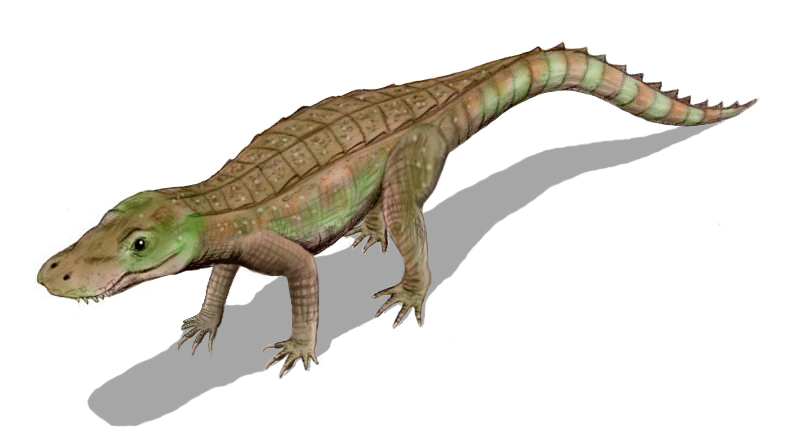[Recent Entries][Archive][Friends][User Info]
February 16th, 2014
| February 16th, 2014 | |
|---|---|
| 01:31 pm [industrialterro] [Link] |
Adamantinasuchus Adamantinasuchus is an extinct genus of notosuchian crocodylomorph from the Late Cretaceous of Brazil. Ziphosuchia is a clade of mesoeucrocodylian crocodyliforms that includes notosuchians and sebecosuchians. First constructed in 2000, it was considered to include Notosuchus, Libycosuchus, and Sebecosuchia. In a 2004 phylogenetic study, it was defined as the most recent common ancestor of Notosuchus, Libycosuchus, and Baurusuchoidea and all of its descendants. Ziphosuchia is often considered to be the sister group of Neosuchia, a clade that includes modern crocodilians. Because the fossil range of Neosuchia extends back to the Early Jurassic with the family Goniopholididae, a ghost lineage of ziphosuchians dating back to that divergence point can be expected. Notosuchia is a suborder of primarily Gondwanan mesoeucrocodylian crocodylomorphs that lived during the Cretaceous. Fossils have been found from South America, Africa, Asia, and Europe. Notosuchia was a clade of terrestrial crocodilians that evolved a range of feeding behaviours, including herbivory (Chimaerasuchus), omnivory (Simosuchus), and terrestrial hypercarnivory (Baurusuchus). It included many members with highly derived traits unusual for crocodylomorphs, including mammal-like teeth, flexible bands of shield-like body armor similar to those of armadillos (Armadillosuchus), and possibly fleshy cheeks and pig-like snouts (Notosuchus). The suborder was first named in 1971 by Zulma Gasparini and has since undergone many phylogenetic revisions. Notosuchians were generally small, with slender bodies and erect limbs. The most distinctive characteristics are usually seen in the skull. Notosuchian skulls are generally short and deep. While most are relatively narrow, some are very broad. Simosuchus has a broadened skull and jaw that resembles a pug, while Anatosuchus has a broad, flat snout like that of a duck. The teeth vary greatly between different genera. Many have heterodont dentitions that vary in shape across the jaw. Often, there are large canine-like teeth protruding from the front of the mouth and broader molar-like teeth in the back. Some genera, such as Yacarerani and Pakasuchus, have extremely mammal-like teeth. Their molars are complex and multicuspid, and are able to occlude or fit with one another. Some forms such as Malawisuchus had jaw joints that enabled them to move the jaw back and forth in a shearing motion rather than just up and down. A derived group of notosuchians, the baurusuchids, differ considerably from other forms. They are very large in comparison to other notosuchians and are exclusively carnivorous. Baurusuchids have deep skulls and prominent canine-like teeth. The clade Notosuchia has undergone many recent phylogenetic revisions. In 2000, Notosuchia was proposed to be one of two groups within the clade Ziphosuchia, the other being Sebecosuchia, which included deep snouted forms such as baurusuchids and sebecids. The definition of Notosuchia by Sereno et al. (2001) is similar to that of Ziphosuchia as it includes within it Sebecosuchia. Pol (2003) also includes Sebecosuchia within Notosuchia. More recently, a phylogenetic analysis by Larsson and Sues (2007) resulted in the naming of a new clade, Sebecia, to include sebecids and peirosaurids. Baurusuchidae was considered to be polyphyletic in this study, with Pabwehshi being a basal member of Sebecia and Baurusuchus being the sister taxon to the clade containing Neosuchia and Sebecia. Thus, Sebecosuchia was no longer within Notosuchia and not considered to be a true clade, while Notosuchia was found to be a basal clade of Metasuchia.
Tags: Вымершие рептилии, Мел, архозавроморфы, архозавры, диапсиды, зифозухии, крокодиломорфы, круротарзы, мезоэукрокодилии, нотозухии, равизухии |
| Time | Event |
| 02:18 pm [industrialterro] [Link] |
Anatosuchus Anatosuchus ("duck crocodile", for the broad, duck-like snout) is an extinct genus of notosuchian crocodylomorph discovered in Gadoufaoua, Niger, and described by a team of palaeontologists led by the American Paul Sereno in 2003, in the Journal of Vertebrate Paleontology. Its duck-like snout coincidentally makes it resemble a crocoduck. The type species of Anatosuchus is A. minor, in reference to its small body size. The holotype material (MNN GDF603), is a nearly complete skull with articulated lower jaws. It was discovered from the upper portion of the Elrhaz Formation and lower portion of Echkar Formation, indicating an Early Cretaceous (Late Aptian or Early Albian). In the initial description of Anatosuchus, it formed a clade with Comahuesuchus, within a less inclusve Notosuchia, also found to be monophyletic. However, further work proposed that Anatosuchus is not closely related to Comahuesuchus. As the specific name indicates, A. minor was a very small crocodylomorph, with an adult body length estimated at around 70 centimeters. It had a very broad, duck-like snout.
Tags: Вымершие рептилии, Мел, архозавроморфы, архозавры, диапсиды, крокодиломорфы, круротарзы, мезоэукрокодилии, нотозухии, равизухии |
| Previous Day | 2014/02/16 [Archive] |
Next Day |









